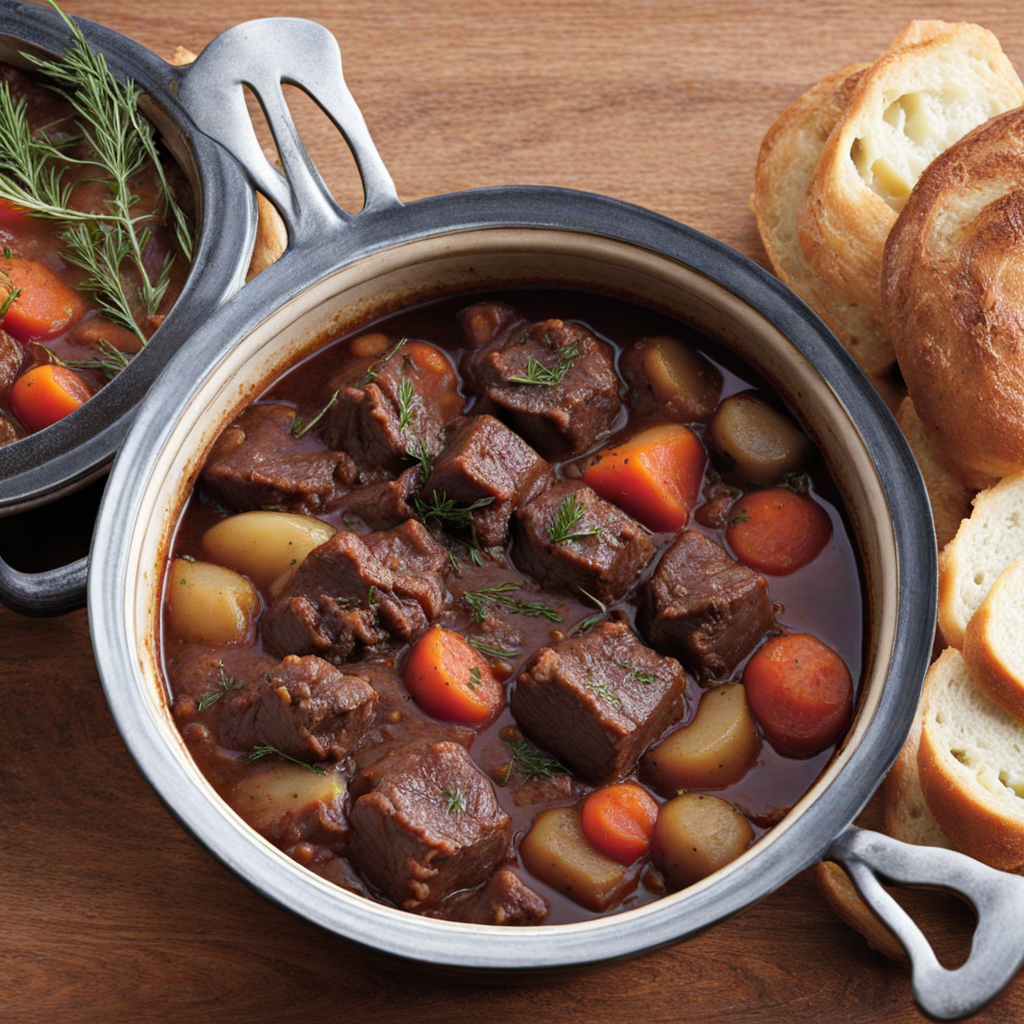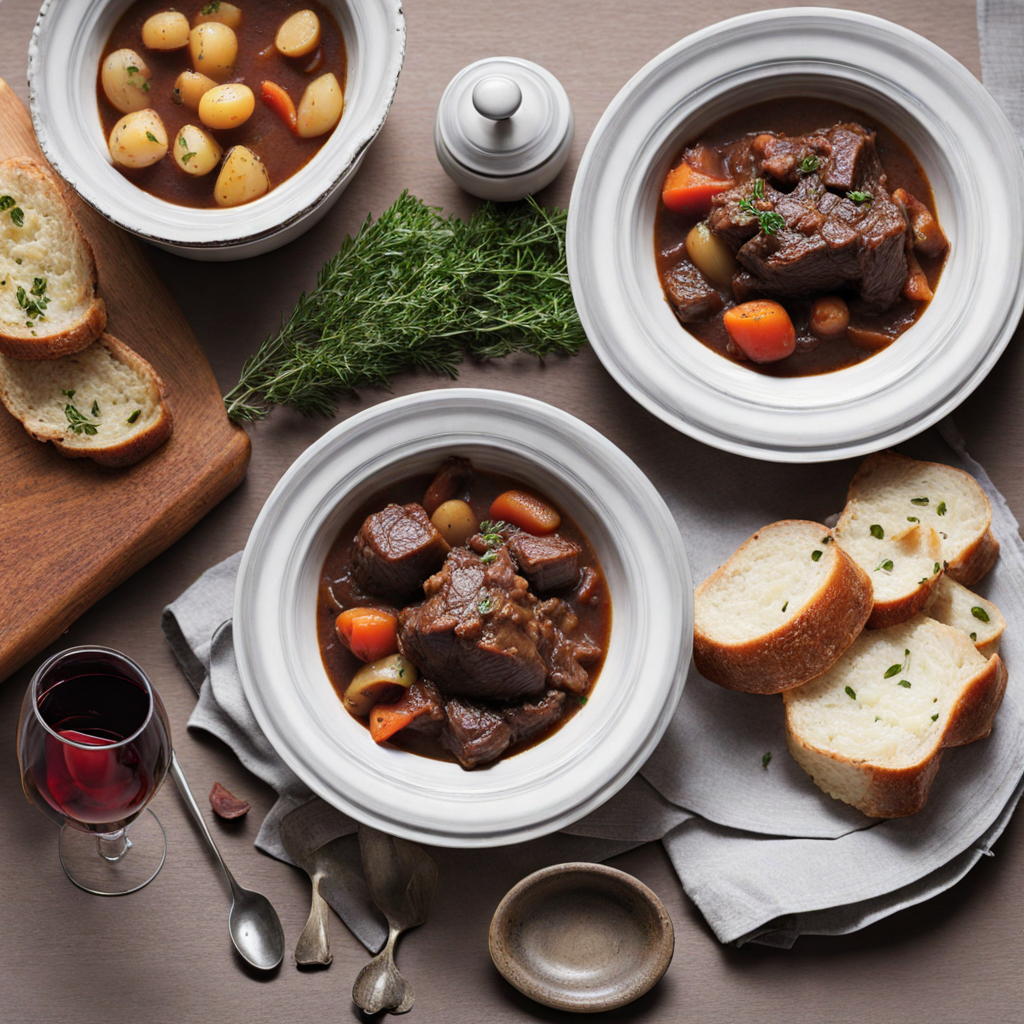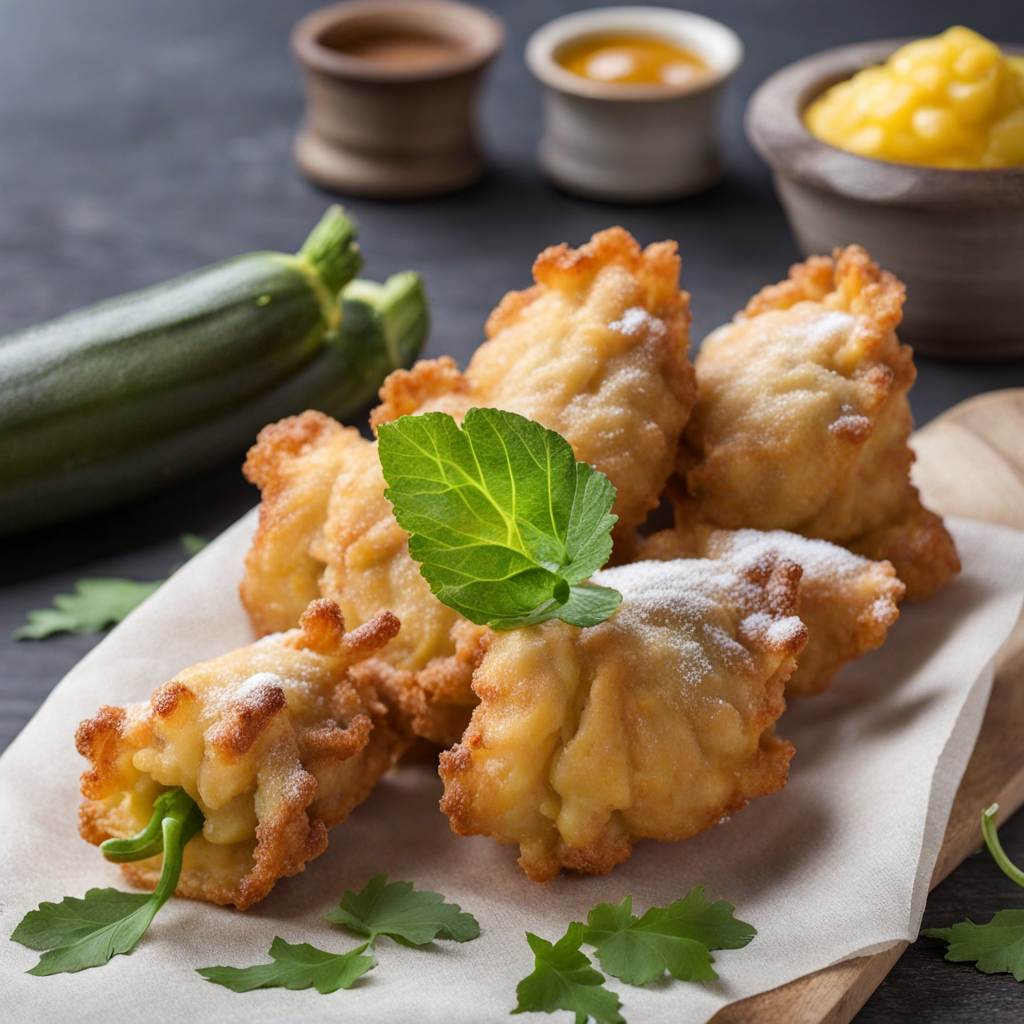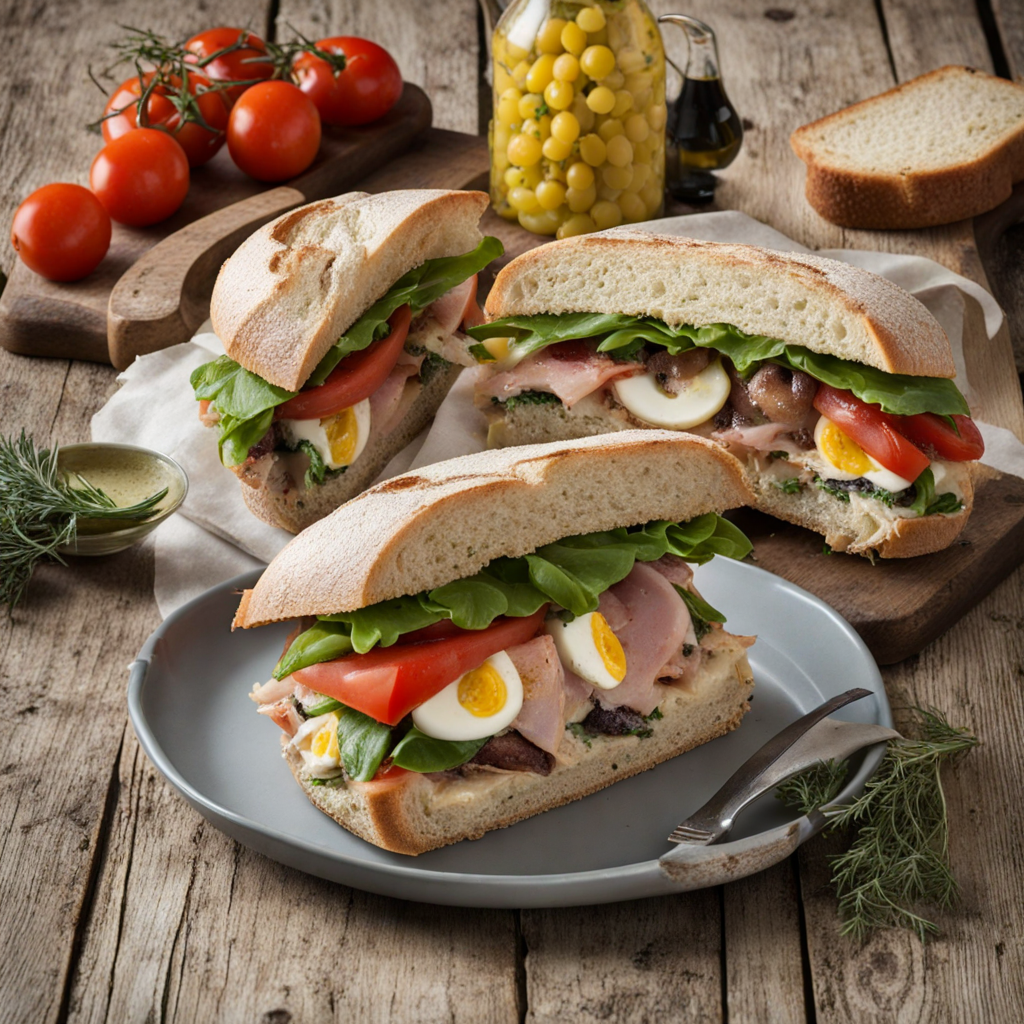Daube Provençale
Daube Provençale is a hearty and flavorful dish that embodies the essence of traditional Monegasque cuisine. Originating from the Provence region in France, this slow-cooked beef stew is characterized by its rich, aromatic sauce made from red wine, garlic, and an assortment of fresh herbs. The combination of these ingredients creates a depth of flavor that is both robust and comforting, making it a perfect dish for cozy gatherings or family meals. The meat is typically braised until tender, allowing it to absorb the vibrant tastes of the sauce, which is often enhanced with elements like olives, tomatoes, and carrots for added sweetness and texture. What makes Daube Provençale truly special is the careful selection of ingredients that reflect the Mediterranean influences of the region. The use of high-quality, locally sourced beef is essential, as it provides a rich base for the stew. Additionally, the inclusion of vegetables and herbs such as thyme, bay leaves, and rosemary adds layers of complexity to the dish. Served with crusty bread or over a bed of creamy polenta, this dish is a celebration of simple yet exquisite flavors, inviting diners to savor every bite. This culinary delight is not only a treat for the palate but also a feast for the senses, with its enticing aroma wafting through the kitchen as it simmers slowly. Each spoonful offers a taste of the sunny Mediterranean, transporting you to the charming streets of Monaco. Daube Provençale is a dish that tells a story, connecting you to the rich culinary traditions of the region while inviting you to experience a taste that is both familiar and uniquely satisfying.
How It Became This Dish
Daube Provençale: A Culinary Journey Through History and Culture Daube Provençale is more than just a dish; it is a testament to the rich culinary heritage of the Provence region in France, with roots that extend into the heart of the Mediterranean. This traditional beef stew, braised in wine with aromatic vegetables and herbs, embodies the essence of French rustic cooking and reflects the agricultural bounty of the region. Its history is intertwined with the cultural evolution of the South of France, particularly Monaco and the surrounding areas, making it a dish that is as rich in story as it is in flavor. Origins: The Roots of Daube The origins of Daube Provençale can be traced back to the Middle Ages, a time when cooking methods were largely influenced by the availability of local ingredients and the methods of preservation. The term "daube" itself is believed to come from the Provençal verb "daubar," which means "to stew." Early recipes for daube likely emerged from the need to make tough cuts of meat palatable. Slow cooking in a liquid, often wine, allowed for the tough fibers to break down, resulting in tender, flavorful dishes. In the Provence region, the use of wine in cooking dates back to ancient times, with the Greeks and Romans cultivating vineyards and influencing local gastronomy. The region's warm climate and fertile lands allowed for an abundance of herbs, vegetables, and livestock to flourish, giving rise to a unique culinary identity that celebrated local ingredients. The traditional use of red wine in Daube Provençale is not merely a flavor enhancer; it is a nod to the region's viticultural heritage. Cultural Significance: A Dish of Community and Tradition Daube Provençale is intrinsically tied to the concept of communal dining and celebration. In historical Provence, it was common for families and friends to gather for long, leisurely meals, particularly during special occasions and festivals. The preparation of daube often involved the participation of multiple family members, turning the act of cooking into a social affair. The dish symbolizes warmth, comfort, and the coming together of loved ones, making it a staple at family gatherings and communal feasts. In Monaco, which shares a culinary lineage with Provence, daube has also found its place in the local gastronomy. The Principality, known for its opulence and rich cultural tapestry, adopted this humble dish, adding its own flair while respecting its traditional roots. Daube Provençale became a popular offering in local restaurants and was celebrated as a dish that represented the spirit of the region—luxurious yet grounded in rustic simplicity. Ingredients and Preparation: The Heart of Daube Provençale At the heart of Daube Provençale lies a combination of simple yet robust ingredients. The primary component is beef, typically a tougher cut such as chuck, which benefits from the long cooking process. The meat is marinated in red wine, often accompanied by herbs like thyme, bay leaf, and rosemary, along with garlic, onions, and sometimes orange peel for a hint of citrus. The marinade not only tenderizes the meat but also infuses it with complex flavors. The cooking process involves browning the meat in a heavy pot, followed by the addition of aromatic vegetables—carrots, celery, and onions—along with the marinade. The mixture is then simmered slowly, allowing the flavors to meld and the meat to become tender. Traditionally, daube is served with a side of pasta or polenta, which soaks up the rich sauce, making for a hearty and satisfying meal. Evolution Over Time: From Rustic to Refined As with many traditional dishes, Daube Provençale has evolved over the centuries. In the 19th and 20th centuries, as travel and trade expanded, the dish began to incorporate influences from various cultures, reflecting the dynamic nature of Mediterranean cuisine. The introduction of new spices, cooking techniques, and even ingredients from North Africa and Italy enriched the flavor profile of daube, making it more complex and diverse. Gastronomic movements in the 20th century, such as the rise of nouvelle cuisine, also had an impact on how daube was prepared and presented. Chefs began to experiment with plating and presentation, transforming this rustic stew into an elegant dish suitable for fine dining. This evolution did not detract from its traditional roots but rather showcased its versatility and adaptability in the contemporary culinary landscape. In modern times, Daube Provençale has seen a resurgence in popularity, particularly as people seek comfort foods that connect them to their heritage. Home cooks and professional chefs alike celebrate the dish for its deep flavors and the stories it carries. It has also found its way onto international menus, allowing people outside of Provence and Monaco to experience this culinary gem. Daube in Contemporary Cuisine: A Dish for All Seasons Today, Daube Provençale is enjoyed year-round, though it holds a special place during the colder months when hearty stews are a comfort to many. It is often prepared for family gatherings, holiday celebrations, and festive occasions, where it continues to serve as a centerpiece that brings people together. Additionally, variations of the dish have emerged, including seafood versions that highlight the coastal influences of the region, showcasing the adaptability of daube. In recent years, there has been a resurgence of interest in traditional cooking methods and local ingredients. Many chefs are returning to the roots of Daube Provençale, emphasizing the use of organic and locally-sourced produce and meats. This trend aligns with a broader movement towards sustainability and conscious eating, ensuring that the flavors of Provence continue to thrive in the modern culinary landscape. Conclusion: A Legacy of Flavor and Community Daube Provençale is a dish that transcends time and place, embodying the spirit of Provence while resonating with the cultural identity of Monaco. Its evolution reflects the dynamic nature of cuisine, where tradition meets innovation, and communal values remain at the forefront. Whether enjoyed in a rustic farmhouse or a chic restaurant, Daube Provençale serves as a bridge between generations, inviting all to partake in the rich tapestry of culinary history. As we savor each bite of this exquisite stew, we are not just tasting a dish; we are experiencing a story—a narrative woven through the ages, marked by the hands of countless cooks who have contributed to its legacy. Daube Provençale stands as a delicious reminder of the importance of food in our lives, fostering connection, celebration, and the joy of sharing a meal.
You may like
Discover local flavors from Monaco







